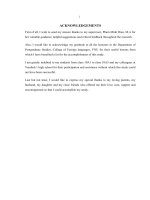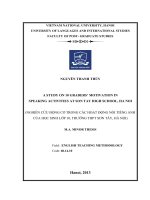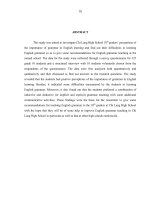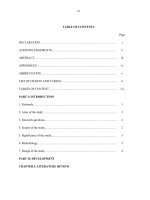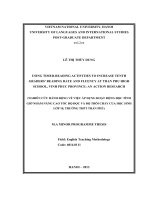Nghiên cứu hành động về việc áp dụng hoạt động đọc tính giờ nhằm nâng cao tốc độ đọc và độ trôi chảy của học sinh lớp 10, trường THPT Trần Phú
Bạn đang xem bản rút gọn của tài liệu. Xem và tải ngay bản đầy đủ của tài liệu tại đây (1.58 MB, 77 trang )
VIETNAM NATIONAL UNIVERSITY, HANOI
UNIVERSITY OF LANGUAGES AND INTERNATIONAL STUDIES
POST-GRADUATE DEPARTMENT
LÊ THỊ THÙY DUNG
USING TIMED-READING ACTIVITIES TO INCREASE TENTH
GRADERS’ READING RATE AND FLUENCY AT TRAN PHU HIGH
SCHOOL, VINH PHUC PROVINCE: AN ACTION RESEARCH
(NGHIÊN CỨU HÀNH ĐỘNG VỀ VIỆC ÁP DỤNG HOẠT ĐỘNG ĐỌC TÍNH
GIỜ NHẰM NÂNG CAO TỐC ĐỘ ĐỌC VÀ ĐỘ TRÔI CHẢY CỦA HỌC SINH
LỚP 10, TRƯỜNG THPT TRẦN PHÚ)
M.A MINOR PROGRAMME THESIS
Field: English Teaching Methodology
Code: 6014.0111
HANOI – 2013
VIETNAM NATIONAL UNIVERSITY, HANOI
UNIVERSITY OF LANGUAGES AND INTERNATIONAL STUDIES
POST-GRADUATE DEPARTMENT
LÊ THỊ THÙY DUNG
USING TIMED-READING ACTIVITIES TO INCREASE TENTH
GRADERS’ READING RATE AND FLUENCY AT TRAN PHU HIGH
SCHOOL, VINH PHUC PROVINCE: AN ACTION RESEARCH
(NGHIÊN CỨU HÀNH ĐỘNG VỀ VIỆC ÁP DỤNG HOẠT ĐỘNG ĐỌC TÍNH
GIỜ NHẰM NÂNG CAO TỐC ĐỘ ĐỌC VÀ ĐỘ TRÔI CHẢY CỦA HỌC SINH
LỚP 10, TRƯỜNG THPT TRẦN PHÚ)
M.A MINOR PROGRAMME THESIS
Field: English Teaching Methodology
Code: 6014.0111
Supervisor: Assoc.Prof.Dr. Trần Xuân Điệp
HANOI – 2013
i
DECLARATION
Lê Thị Thùy Dung, hereby declare that the work contained in this thesis is my own
research. It is recognized that should this declaration be found to be false,
disciplinary action could be taken and penalties imposed in accordance with
University policy and rules.
Signature
Lê Thị Thùy Dung
ii
ACKNOWLEDGEMENTS
This thesis would not have been completed without the help, assistance and support
of many people to whom I am indebted.
First of all, I would like to express my deepest thanks to my supervisor, Mr. Tran
Xuan Diep, Assoc. Prof. Dr. for the wholehearted guidance he gave me while I was
doing this research. I am truly grateful to him for his ideas, comments and
instructions, as well as his constant support throughout my research.
I would like to thank all the lecturers who taught me during the post graduate
course. They provided me with valuable knowledge in various aspects that I used to
carry out my study.
I also would like to thank all the staff members of the Department of Post graduate
study, Vietnam National University for providing me best help and assistance to
fulfill my thesis.
I wish to express my deep gratitude and appreciation to the administrators of Tran
Phu High School, my colleagues at English Group for their constant support, co-
operation, and encouragement while the study was in progress.
My sincere thanks go to the students of class 10B who participated in my study and
helped me with data collection for this study.
Finally, I owe my deep thanks to my dear family, specially my parents and my
younger brother who were standing for me with love, help, consideration and
encouragement.
iii
ABSTRACT
It has been acknowledged that reading rate and comprehension are closely linked.
Slow readers read at low rate with poor comprehension. The rate of 200 - 300 wpm
is considered the target rate for L2 students to reach to gain full comprehension
(Alderson, 1984; Anderson, 1999; Carver, 1990; Dubin and Bycina, 1991).
However, the 10
th
graders‘ reading rate at Tran Phu High School was far below the
target. It is necessary to increase the students‘ reading rate and timed reading
activity was applied as a technique to help students reach the target.
This action research has attempted to examine the effectiveness of timed reading
activity in increasing 10
th
graders‘ reading speed and their fluency. This study also
has investigated into the students‘ attitudes towards timed reading activity. To reach
these objectives, an action research was carried out. The participants of the study
were 40 non - English - major 10
th
graders from one class at Tran Phu High School,
which was divided into 2 groups, fast readers and slow readers. Timed reading
activity was implemented during 8 weeks. The data collection instruments were
questionnaires (pre-questionnaire, post questionnaire), reading rare chart, and tests
(pretest, posttest).
The results obtained from the analyzed data show that the use of timed reading
helped raise students‘ reading rate and comprehension, especially in fast reader
group. Furthermore, most of the students expressed positive attitudes towards timed
reading activity.
iv
LIST OF TABLES
Table 1: Participants’ background information
17
Table 2: Mean reading rate measured by wpm at the Pretest and
Posttest
26
Table 3: The students’ reading comprehension at the Pretest and
the Posttest
28
v
LIST OF CHARTS
Chart 1: Changes in reading rate at the Pretest and Posttest
27
Chart 2: Changes in reading rate of slow readers and fast
readers
28
Chart 3: Changes in reading comprehension of slow readers
and fast readers
29
Chart 4: The pre-questionnaire’s result
30
Chart 5: The post-questionnaire’s result (part I)
30
Chart 6: General feelings about timed reading activity
32
Chart 7: Feelings about the operation in timed reading activity
32
Chart 8: Belief on the effects of timed reading activity
33
Chart 9: Opinions about the use of timed reading activity
34
vi
LIST OF ABBREVIATIONS
wpm: words per minutes
vii
TABLE OF CONTENTS
DECLARATION………………………………………………………………….i
ACKNOWLEDGEMENTS……………………………………………………….ii
ABSTRACT……………………………………………………………………….iii
LIST OF TABLES……………………………………………………………… iv
LIST OF CHARTS……………………………………………………………… v
LIST OF ABBREVIATIONS…………………………………………………… vi
PART A:
Introduction…………………………………………………………….Error!
Bookmark not defined.
I.
Rationale……………………………………………………………………… Err
or! Bookmark not defined.
II. Aims and objectives of the
study……………………………………………….Error! Bookmark not defined.
III. Research
Questions…………………………………………………………….Error!
Bookmark not defined.
IV. Scope of the
study…………………………………………………………… Error! Bookmark
not defined.
V.
Methods…………………………………………………………………………Erro
r! Bookmark not defined.
VI. Significance of the
study…………………………………………………… Error! Bookmark not
defined.
VII. Design of the
study……………………………………………………………Error! Bookmark
not defined.
PART B:
DEVELOPMENT……………………………………………………….Error!
Bookmark not defined.
viii
CHAPTER 1: THEORETICAL
BACKGROUND……………………………… Error! Bookmark not defined.
1.1.
Reading……………………………………………………………………… Error
! Bookmark not defined.
1.2. Reading
fluency……………………………………………………………… Error!
Bookmark not defined.
1.3. Reading
rate……………………………………………………………………Error!
Bookmark not defined.
1.4. Reading rate
activities…………………………………………………………Error! Bookmark
not defined.
1.4.1. Rate-buildup reading
……………………………………………………… Error! Bookmark not
defined.
1.4.2. Repeated
Reading………………………………………………… Error! Bookmark
not defined.
1.4.3. Class-paced
reading…………………………………………………………Error! Bookmark
not defined.
1.4.4. Self-paced
reading………………………………………………………… Error! Bookmark
not defined.
1.5. Timed reading
activity……………………………………………… Error! Bookmark
not defined.
1.6. Previous related
studies……………………………………………………….Error! Bookmark not
defined.
CHAPTER II:
METHODOLOGY…………………………………………………Error!
Bookmark not defined.
ix
2.1. Participants and setting of the
study………………………………………… Error! Bookmark not defined.
2.1.1.
Participants………………………………………………………………… Error!
Bookmark not defined.
2.1.2. Setting of the
study………………………………………………………….Error! Bookmark not
defined.
2.2. Methods and
procedures………………………………………………………Error! Bookmark
not defined.
2.2.1.
Methods…………………………………………………………………… Error!
Bookmark not defined.
2.2.2.
Procedures……………………………………………………………… Error!
Bookmark not defined.
2.2.3 Instruments of data
collection……………………………………………… Error! Bookmark not
defined.
2.2.3.1 Pretest and posttest
……………………………………………………… Error! Bookmark not
defined.
2.2.3.2. Students‘ reading rate
chart…………………………………………… Error! Bookmark not defined.
2.2.3.3.
Questionnaires…………………………………………………………….Error!
Bookmark not defined.
2.2.4. Data collection
procedure………………………………………………… Error! Bookmark not
defined.
CHAPTER III: DATA ANALYSIS AND
FINDINGS……………………………Error! Bookmark not defined.
x
3.1. Students‘ reading
rate…………………………………………………………Error! Bookmark not
defined.
3.2. Students‘ reading
comprehension…………………………………………… Error! Bookmark not
defined.
3.3. Students‘ attitudes towards timed reading
activity……………………………Error! Bookmark not defined.
3.3.1. The pre-questionnaire and part I of the post-questionnaire: The participants‘
general perception on
reading…………………………………………………… Error! Bookmark not
defined.
3.3.2. Part II of the post-questionnaire: The participant‘s attitudes towards timed
reading
activity…………………………………………………………………… Error!
Bookmark not defined.
3.3.2.1. The participants‘ feelings about timed reading
activity………………… Error! Bookmark not defined.
3.3.2.2. The participants‘ belief on the effects of timed reading
activity………….Error! Bookmark not defined.
3.3.2.3. The participants‘ opinions about the use of timed reading activity in the
future.
………………………………………………………………………………E
rror! Bookmark not defined.
3.4.
Findings……………………………………………………………………… Error
! Bookmark not defined.
3.5. Implication of the
study……………………………………………………….Error! Bookmark not
defined.
PART C:
CONCLUSION………………………………………………………….Error!
Bookmark not defined.
xi
I.
Recapitulation……………………………………………………………………Err
or! Bookmark not defined.
II. Limitations of the
study…………………………………………………………Error! Bookmark not
defined.
III. Suggestions for further
research……………………………………………….Error! Bookmark not
defined.
REFERENCES…………………………………………………………………… E
rror! Bookmark not defined.
APPENDIXES I
APPENDIX 1: READING RATE CHART I
APPENDIX 2: PRETEST II
APPENDIX 3: POSTTET VI
APPENDIX 4A: PRE QUESTIONNAIRE (English) X
APPENDIX 4B: PHIẾU KHẢO SÁT Ý KIẾN HỌC SINH 1 (Vietnamese) XI
APPENDIX 5A: POST QUESTIONNAIRE (English) XII
APPENDIX 5B: PHIẾU KHẢO SÁT Ý KIẾN HỌC SINH 2 (Vietnamese) XV
APPENDIX 6: SAMPLE OF LESSON XVII
xii
1
PART A: Introduction
I. Rationale
Reading skill is one of the four language skills that language learners need to
master. The four skills, which are interdependent, are of importance in the success
of one‘s language acquisition. In regard to reading skill, it is vital for learners to
acquire this skill, because they can receive information on vocabulary, grammar as
well as knowledge about life. Reading keeps their cognitive abilities developed.
Thus, teaching reading plays an important role in teaching a foreign language in
general and English in particular.
However, teaching reading is a really challenging job. It takes much time and
energy to make progress in this skill. For teachers, it is a difficult task to get
students complete reading activities accurately and punctually. For students, they
often have to struggle with reading tasks because of the lack of specific skills
necessary for proficient reading especially in a limited time, which is popular in
Vietnamese high schools. And in Tran Phu High school where the writer is
working, this problem happens in the same way. The 10
th
graders at Tran Phu High
School had great difficulty in doing reading tasks in allotted time. Their reading
rate, which was measured in the reading test before the research, was very slow
(around 80 wpm) whereas many authors prove that the optimal reading speed
for L2 readers should be around 200 – 300 words per minute (wpm)
(Alderson, 1984; Anderson, 1999; Carver, 1990; Dubin and Bycina, 1991).
According to Nuttall (1996), slow reading rate leads to the frustration in her
description of the ―vicious cycle of the weak reader‖. Faster reading encourages the
reader to read more; as a result, comprehension improves.
Increasing reading rate, which is essential, can be done through reading rate
activities. Later studies show that readers achieve not only rapid-reading skills but
also better comprehension when specifically taught rapid-reading techniques
(Cranney, Brown, Hansen, and Inouye 1982). There have been a lot of reading rate
2
activities such as rate-buildup reading, repeated reading, class-paced reading and
self-paced reading (Neil J. Anderson 1999).
Timed reading activity is one of reading rate activities which can help improve 10
th
graders‘ reading rate. Therefore, I conducted a research to find out how timed
reading activity helped increase the student‘s reading rate and improve their
fluency.
II. Aims and objectives of the study
The study is aimed at to improving the students‘ reading skills through timed
reading activity.
Objectives of the study are to examine the effects of timed reading activity on tenth
graders‘ reading rate and fluency at Tran Phu High School, Vinh Phuc Province and
to explore their attitudes towards timed reading activity
III. Research Questions
In correspondence with the aforementioned aims and objectives, the researcher
attempted to answer the following questions:
RQ 1: To what extent does timed reading activity affect learners‘ reading rate and
fluency?
RQ 2: What are the students‘ attitudes towards timed reading activities as a
technique used to improve their reading rate and comprehension?
IV. Scope of the study
The study focuses on testing the hypothesis ―Timed-reading activity can increase
tenth graders‘ reading rate and fluency at Tran Phu High School, Vinh Phuc
Province‖. The study of factors affecting learners‘ reading rate would be beyond the
scope of the study.
V. Methods
The study is to be conducted as an action research that utilizes quantitative research
method. The quantitative analysis is used to deal with the data collected from
reading rate chart, pretest and posttest, pre-questionnaire and post questionnaire.
3
VI. Significance of the study
The study is significant for the followings. Firstly, the study will help the researcher
suggest a better way to improve students‘ reading skills in certain contexts.
Secondly, the study will bring about possible insights into the reading skill
development and motivation of the students in the 10th class at Tran Phu high
school in Vinh Phuc. Thirdly, the study will help increase the student‘s reading rate
and comprehension. Finally, the study will be initial considerations for future
studies on the similar issues on both non-English and English major students at high
schools.
VII. Design of the study
The thesis consists on three parts.
Part A deals with the introduction. This chapter provides the rationale, aims,
objectives, research questions, scope, method, significance, and design of the study.
Part B presents the development, which includes three chapters.
Chapter 1 deals with theoretical background and academic viewpoints on reading,
reading fluency, reading rate, and timed reading activity. Some research works
related to the current study are also presented in this chapter.
Chapter 2 describes methodology. This chapter is composed of description of
methodology of the study, participants and setting of the study, data collection
instruments, data collection procedure, and data analysis procedure.
Chapter 3 presents data analysis and discussion. This chapter analyses, discusses
the results achieved from the study and offers some implications of the study.
Part C is the conclusion that presents the author‘s reflection and the outcomes of
the study as well as indicates some limitations of the study and finally gives some
suggestions for further research.
4
PART B: DEVELOPMENT
CHAPTER 1: THEORETICAL BACKGROUND
This chapter reviews theories related to the definitions of reading, reading fluency,
reading rate and timed-reading activity. It also summarizes some previous studies
on timed-reading activities and reading speed.
1.1. Reading
Reading is one of the most important skills to master. It is known as a complex
cognitive process of decoding symbols in order to construct or derive meaning.
There have been a lot of different definitions of reading according to various
scholars.
Kenneth Goodman(Goodman, 1967) describes reading as receptive language
process and uses the metaphor of guessing game to describe a reading act.
Reading is a psycholinguistic guessing game. It involves an interaction between
thought and language. Efficient reading does not result from precise perception and
identification of all elements, but from skill in selecting the fewest, most productive
cues necessary to produce guesses which are right the first time. The ability to
anticipate that which has not been seen, of course, is vital in reading, just as the
ability to anticipate what has not yet been heard is vital in listening. (Goodman,
1967)
According to Rumelhart (1977) and Stanovich (1980), reading is the process in
which the interaction among the reader, the text and the context occurs. In other
words, comprehension is a complex process which involves a mixture of elements
depending on one another.
1.2. Reading fluency
Reading fluency has become a crucial matter in English as a first language (L1)
setting (Taguchi, Gorsuch, & Sasamoto, 2006). Segalowitz (2000) states that
fluency, regardless of whether in reading, speaking, listening, or musical
performance, often refers to three components: accuracy, speed, and fluidity. In the
case of reading, fluency has been widely characterized as ―the ability to read text
5
rapidly, smoothly, effortlessly, and automatically with little attention to the
mechanics of reading such as decoding‖ (Meyer, 1999, p.284).
Hudson, Lane, and Pullen (2005) state ―Reading fluency is one of the defining
characteristics of good readers.‖ Each of the features of fluent reading can be linked
to reading proficiency. Reading accuracy is related to reading proficiency because it
encompasses many reading skills. In order to accurately identify words students
must utilize visual, semantic, and syntactic cuing systems. Students must have a
strong ability to combine phonemes, recognize phonograms, and be aware of sound-
symbol correspondence. The characteristics of reading fluency, effortless word
recognition, reading in meaningful phrases, reading at an appropriate rate, and
prosodic reading, if done automatically, allow cognition to be focused on
comprehending the text (Hudson, et al., 2005).
Reading fluency is the ability to recognize words rapidly and accurately (Taguchi,
et al., 2006; Taguchi, Takayasu-Maass, & Gorsuch, 2004). These authors share the
same idea that reading fluency requires a certain level of accuracy and rate which
readers can decode the texts effortlessly and contribute most of the attention on
comprehending. In short, the authors agree that three components of fluency include
accuracy, reading rate, and comprehension.
Of these three components of reading fluency, reading rate is assessed as the
fundamental factor. Samuels asserts, ―for the purposes of fluency, speed rather than
accuracy should be stressed‖. The statement is based on the loss of fluency in
efforts to obtain 100% word accuracy. Slow reading necessarily results in less
reading. It is also difficult for a slow reader to comprehend because the rate at
which a slow reader moves through a text makes it difficult to hold on to the
meaning. Besides, slower readers become more frustrated which lowers motivation.
Finally, instruction must aim to create faster, more fluent readers. The fear of losing
comprehension, neglecting prosody, ignoring word recognition because of reading
rate is evident then and now. Still, reading rate cannot be neglected (Rasinski,
2000).
6
In the earliest studies on reading speed, it is pointed out that rapid reading is only a
skimming strategy used to go through the reading material (Brown, Inouye, Barrus,
and Hansen 1981). Recent researchers; however, have shown that rapid-reading
techniques help readers gain both faster reading rate and better comprehension
(Cranney, Brown, Hansen, and Inouye 1982).
Klaeser (1977, as cited in Jeremy Browning, 2003) presents four benefits from
gaining a faster reading rate. The first one is the amount of time students will save
when they are able to raise their speed. With an increase in speed, students will be
able to cover more materials than at a slower speed. The second advantage is that
readers are able to concentrate better which leads to greater comprehension. Of
course this area is under debate because there have been studies of students that lost
comprehension when they were striving to increase their reading speed. This is
usually the cause of "rushed reading" and contains little more technique than
scanning. However, it is believed that through an "effective" timed reading
program, students can attain an increased reading rate and comprehension. Thirdly,
with the increase in potential speed and comprehension, academic grades tend to
rise as well. Lastly and most importantly, students will enjoy the act of reading
more, which promotes greater extensive reading, an added area for increased
reading speed and comprehension. With increased reading rate and motivation for
extended reading, students will encounter frequent and repeated vocabulary, which
will transcend into other areas of language skills development. Reading rate
activities obviously help students have these four ―positive points‖ to become
successful readers.
According to Nuttal (1996:127), the frustration resulting from slower reading
is stated in her description of the ―vicious cycle of the weak reader.‖ Readers with
poor comprehension often slow down their reading speed and then do not enjoy
reading because it takes so much time. Therefore, they do not spend much time on
this skill, so the vicious cycle is continued. Nuttall recommends that by increasing
7
reading rates, the reader can get into the ―virtuous cycle of the good reader.‖ Faster
reading encourages the reader to read more; as a result, comprehension improves.
1.3. Reading rate
The ability to process information automatically is an important aspect of many
everyday skills, including reading. Good readers seem to complete word recognition
tasks ―automatically and effortlessly‖, thus allowing them to concentrate their
cognitive force on comprehending text (Taguchi, et al., 2004). This notion is now
widely accepted in both English as L1 learning contexts (e.g: Perfetti, 1985), and
English as L2/FL learning contexts (e.g: Anderson, 1999; Chang, 2010; Grabe,
1991). They all prove that automaticity is very important in ―comprehension
processes, which involve understanding text meaning, interpreting the ideas
represented in the text, using reading strategies if necessary, making inferences,
drawing on background knowledge, and evaluating the information being read‖
(Chang, 2010, p. 285). Chang (2010) also suggests that ―automaticity arises through
constant practice of a routine procedure, like playing a piano or driving a car‖ (p.
285), it means that automaticity might develop better through daily reading rate
activities.
In fluent reading, word recognition is sufficiently automatic and accurate so that a
reader‘s attention is focused on the meaning of the text (LaBerge & Samuels, 1974).
Fluent reading does not prevent hesitating or pausing to decode unknown words.
However, it is unlikely that readers will have a high-quality interpretation of a text
when many words need to be decoded. The breaking point at which the number of
known words is insufficient for constructing a useful interpretation of a text is
determined by reader proficiency and background knowledge. Fluent readers know
the majority of the words automatically and attend to less frequent words in texts;
thus, the aim of fluency practice would seem to be to increase the automatic
response of beginning and struggling readers to the words that account for the
majority of the words in texts.
8
Automaticity usually forms and develops little by little. The more traces are added
to memory, the stronger the response of memory to a familiar situation becomes,
but in principle, it can occur in a single trial. Logan (1991) show that 15 minutes of
memorization produces automaticity in an arithmetic analog task that is similar in
many ways to the automaticity produced after 12 sessions of practice on the task
itself. They go on to show that memorization is not more effective than practice on
the task itself—subjects in the 12-session practice experiment had many more
problems to learn than subjects in the 15-minute memorization experiment—but
they make the point that extensive practice is not necessary to produce automaticity.
LaBerge and Samuels (1974) also help make the way reading fluency builds up
clear. Automaticity means ability to perform some arbitrary task at a competent
level without requiring conscious effort. Moreover, if the student is automatic or is
"a skilled reader, multiple tasks are being performed at the same time, such as
decoding the words, comprehending the information, relating the information to
prior knowledge of the subject matter, making inferences, and evaluating the
information's usefulness to a report he or she is writing" (Samuels).
While automaticity is considered fundamental to fluent reading abilities, working
memory in fact is the major factor of this process (Alptekin & Ercetin, 2011; Grabe,
2004). Working memory is composed of a ―limited-capacity intentional control
system—limited storage, limited abilities‖ to manage multiple processes at the same
moment, and keeping information for just very short periods of time (Chang, 2010).
Consequently, due to the rules of working memory, in reading processes, less
attention will be put on comprehending content if more attention is expended on
completing word recognition tasks (e.g., word decoding) (Chang, 2010).
Reading fluency is generally achieved through automatization of word recognition,
which allows one to pay more attention on the meaning of the text rather than on
decoding words. Grabe (1991) states that ―fluent reading is rapid; the reader needs
to maintain the flow of information at a sufficient rate to make connections and
inferences vital to comprehension‖. Reading fluency is usually measured by reading
9
rate, calculated by words per minute (wpm). Conflicting data exist regarding the
optimal or sufficient reading rate. Hinggins and Wallace (1989) suggest that 180
words per minute ―may be a threshold between immature and mature reading and
that a speed below this is too slow for efficient comprehension or for the enjoyment
of the text‖. Jensen (1986, as cited in Anderson, 1999) suggests that the optimal rate
is 300 words per minute which helps L2 readers seek to ―approximate native
speaker reading rates and comprehension levels in order to keep up with
classmates‖. Many authorities shared the similar speed. According to Carver (1990),
speed is closely tied to reading process and each has a typical rate. He concludes
that efficient reading takes place at the speed of 300 wpm. If a person‘s reading
speed is faster or slower than 300 wpm, he is not reading; he would be scanning,
skimming, learning, or memorizing the material. Dubin and Bycina (1991) state that
― a rate of 200 words per minutes would appear to be the absolute minimum in
order to read with full comprehension.‖ Based on the review of literature on the
issue of adequate reading rate, the rate of at least 200 wpm with at least 70%
comprehension is considerable a reasonable goal for most of the L2 students to
attain (Anderson, 1999). However, many L2 college students act far below these
figures (Nation, 2005; Taguchi, et al., 2004). Although only automaticity in word
processing is not enough to determine reading comprehension, which can be widely
affected by many other factors (Fraser, 2007 as cited in Chang, 2010), such as
―reading purposes, tasks, text difficulty (involving grammatical structure and
vocabulary), as well as topic familiarity, or even readers‘ physical condition (e.g.,
being tired or unable to concentrate)‖, it is considered as a good indicator of reading
fluency because ―fluent readers usually have fast word recognition abilities‖
(Chang, 2010).
Therefore, to improve students‘ reading fluency, it is necessary to help them have
such ―fast word recognition abilities‖ which can be achieved through reading rate
activities. Up to now, there has been a certain amount of research investigating the
10
reading rate activities, each of which has its own advantages in improving students‘
reading fluency. These activities will then be presented briefly in the next part.
1.4. Reading rate activities
This part will present the activities aimed at improving the students‘ reading rate
and then their reading fluency.
There have been four significant recommendations related to pedagogical
techniques for rapid reading. Harris (1966) suggests exercises dealing with word
recognition, vocabulary building, and selections used for timed reading ―Reading
Improvement Exercises for Students of English as a Second Language‖. The two
techniques he recommends are skimming and scanning. Students are given
instructions to read the passage as quickly as possible. Plaister (1968) proposes the
use of metronome in increasing reading speed. The metronome is used as a pacer
with a 3 x 5 index card to read through the teacher‘s prepared materials. The goal is
to read a line of text in a fixation of the eye, then moving to the next line with the
beat of the metronome. Seliger (1972), on the other hand, proposes a method of
previewing, scanning, directed reading with the using the finger as a pacer to reduce
eye regressions. Finally, another method referred to as ―phrase reading‖ is
suggested by Riley (1975). Like the one proposed by Plaister, this method
advocates teaching students to increase their eye span by reading in units.
Instructions are given to focus on an imaginary vertical line down the center of the
passage and through the use of the eye span to read the materials.
The four methods make the use of mechanical devices, specially prepared materials
by the teacher, or simple instructions to ―read as quickly as possible‖.
Basing on reading rate development theories and practice in first and second
language reading, Anderson, N. J. (1999) suggests four reading rate activities used
in the second language reading class to increase students‘ reading rate as followed:
1.4.1. Rate-buildup reading
According to Anderson, in this activity students have 60 seconds to read as much
material as they can. They are then given an additional 60 seconds to read again
11
from the beginning of the text. They must read more material during the second 60-
second period than in the first. The drill is repeated a third and fourth time. The
purpose of this activity is to reread ―old‖ material quickly, gliding into the ―new.‖
As their eyes move quickly over the old material, students actually learn how to
process the material more quickly. The exercise does not really emphasize moving
the eyes quickly; instead, the material should be processed and comprehended more
efficiently. As students participate in this rate building activity, they learn that
indeed they can increase their reading rates.
1.4.2. Repeated Reading
The repeated reading activity develops reading rates as students read a short passage
over and over again until they achieve criterion levels of reading speed and
comprehension. For example, students may try to read a 100-word paragraph four
times in two minutes. The criterion levels may vary from class to class, but
reasonable goals to work toward are criterion levels of 200 words per minute at 70
percent comprehension.
As a method of improving reading fluency, repeated reading, which is developed by
S. Jay Samuels, is the practice of rereading a short text passage until a set level of
speed and accuracy has been reached. Samuels‘s repeated reading method was
grounded in the automaticity theory that he developed with his colleague David
Laberge, suggesting that comprehending text is less difficult for fluent readers
because they decode text automatically.
Research such as that by Patricia Koskinen and Irene Blum (1986) finds that
repeated reading in assisted or unassisted methods, improves both fluency and
comprehension at all reading levels and on novel texts as well as on those that were
read repeatedly. The work of these scholars collectively emphasizes the repetitive,
practiced nature of acquiring a preset level of speed and accuracy.
As the student continued to use this technique, the initial speed of reading each new
selection was faster than the initial speed on the previous selection. Also, the
number of re-readings required to reach the criterion reading speed decreased as

